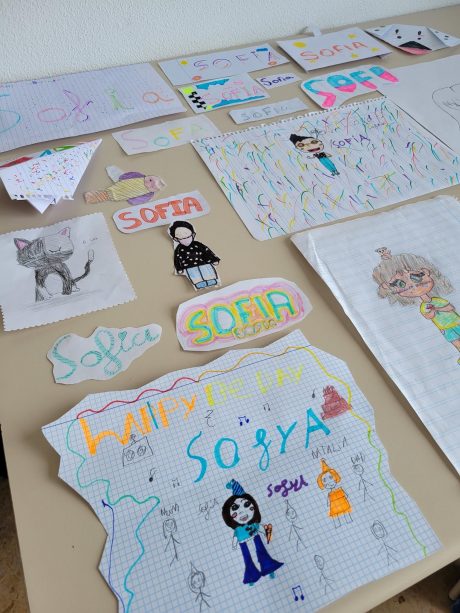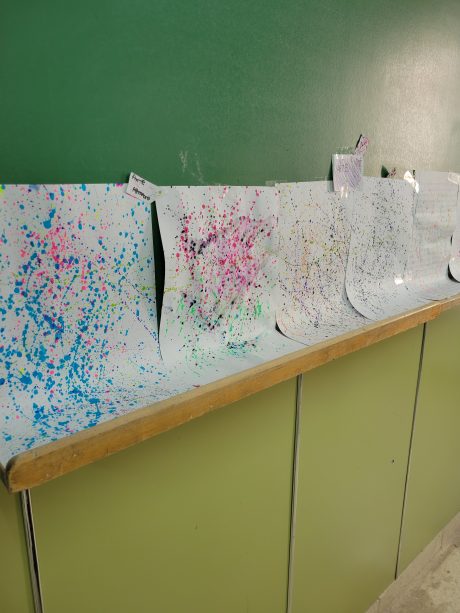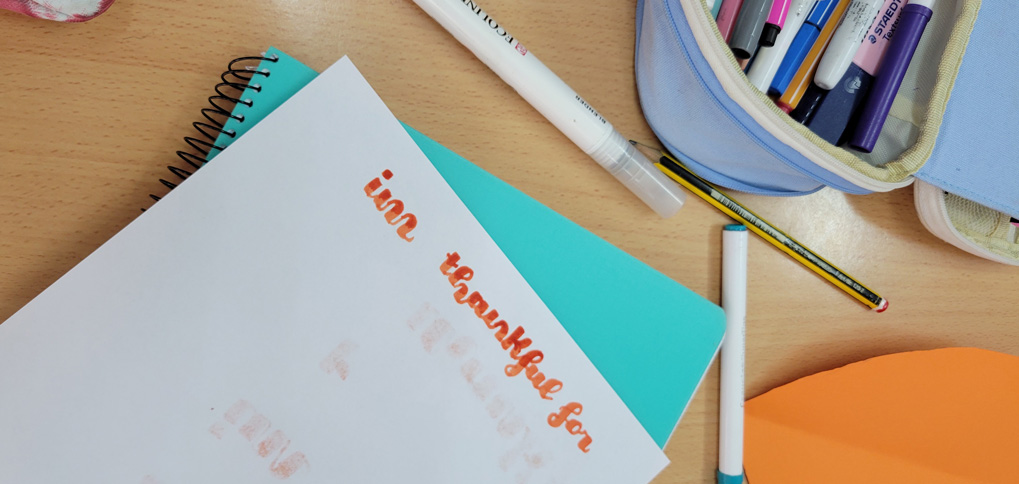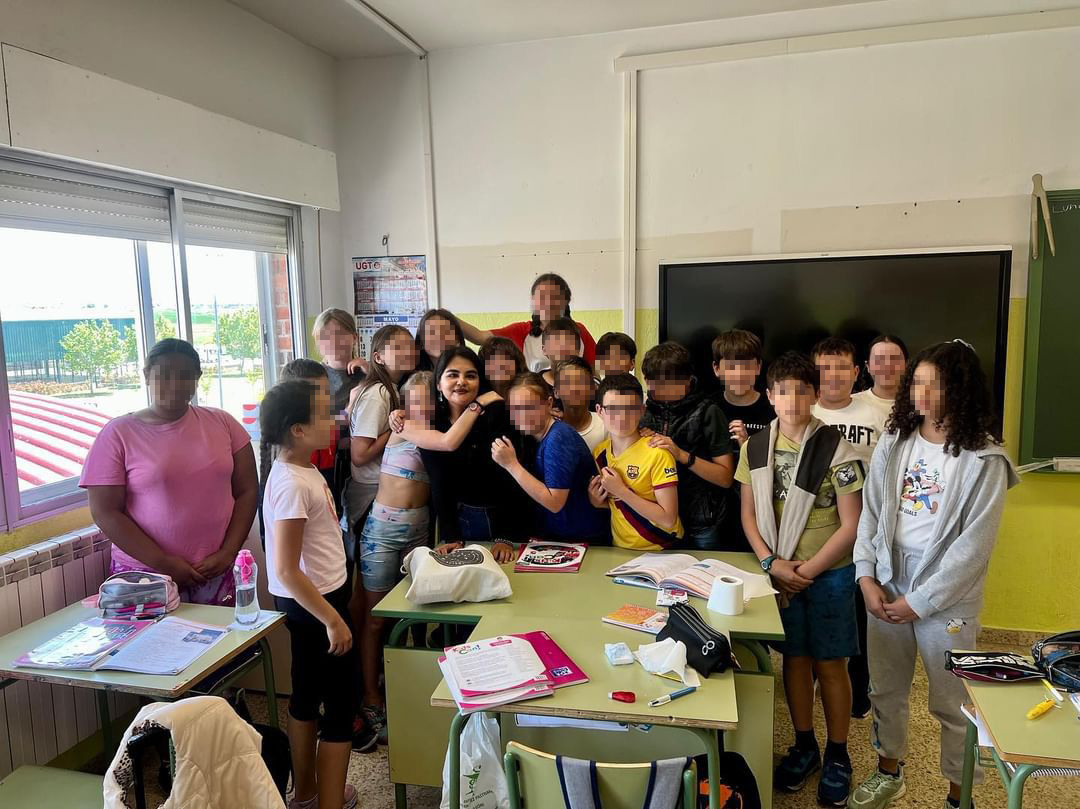By Sofia D., Auxiliar de Conversación in Murcia 21/22
Ah, primary school… grades 1-6 can be as adorable as they are overwhelming at times. These energetic kids are bound to find you interesting since you’ve come from so far away. I believe that they really do love learning. However, they also have a tendency to lose focus faster than gossip spreads in the schoolyard- and your newness is bound to wear off eventually. That’s why I’m coming with some teaching tips.
For the past few months, I have been speaking to teachers and fellow auxiliares looking for the best ways to handle teaching these kids a second (or, as in some cases, a third or fourth) language. I came into the ConversaSpain program without any teaching experience so I was playing catch-up for more than just my first few classes.
Now I feel so much more confident in the classroom thanks in no small part to what all those friends and colleagues shared with me and what I figured out for myself through trial and error.
Here, I hope to arm you, dear reader, with some teaching tips: a few hard-won, tried and true methods to help you not only win the attention of the class, but also keep it long enough to help them learn something from you (hopefully all while keeping your own sanity intact!). At the end of the day, your goal is to use their energy to your benefit and make sure classes with you seem like a reward rather than a chore.
Keep your energy high in the classroom!
Have you ever heard of a “customer service voice”? It’s that special voice that people in the service industry use when speaking to customers that’s designed to be a little more cheery and bubbly than their normal speaking voice. I figured out early on that my normal speaking voice just isn’t that effective when it comes to grabbing attention in the classroom.
The more energetic and excited I sound, however, the more excited the kids seem to be about the lesson. This has led to me developing a distinct “classroom voice” that sounds somewhere between a motivational speaker and a cartoon character- but it works!
It has reached the point where if I slip out of the classroom voice for a moment, the class seems to immediately lose any momentum we’ve built up. Work on your own “classroom voice” little by little; the goal isn’t to sound fake or exaggerated, just cheerful enough for your students to mirror your excitement.
Have an attention grabber (or two!)
These handy words or phrases help quell those distracting back of the classroom conversations. Ok, picture this: you’re giving a presentation to the class and though most of the class is paying attention and listening, a handful of pesky little whispered conversations have popped up around the classroom.
What do you do now? I know some auxiliares are fans of the “I’ll wait…” approach, but sometimes if you need to use that enough, it backfires and you end up having to wait so long that the lesson plan has to be cut short. What if the whole class just got back from their break and they’re all carrying on? Just waiting around won’t change anything there either.
In these situations, I am a major fan of call-and-response attention grabbers. For example, I found myself asking my students if they were looking, listening, and ready to continue the lesson so many times that it became our attention grabber almost by accident.
If I notice their attention slipping, I stop what I’m doing and ask “Are we looking, yes or no?” After a few kids respond I follow up with “Are we listening?” By this point I have most of the room dialed in, so after most of their yes’s I wrap up with “Are we ready?” That’s when I get the full room yelling “Yes, teacher!” and I know they’re ready to continue.
Teaching Tips: Some examples
Something as simple as this attention grabber has cut through the din of a full classroom of screaming first graders as well as quelled those sneaky side conversations in the middle of a presentation to sixth graders with equal effectiveness.
I have also heard of some auxes using a line of a song that the kids complete, hand claps in a rhythm that the kids copy, or even a gamified attention getter like “If you can hear me, put your hands on (your head, your knees, your ears, etc.)” to add an element of play to rope the kids back into the lesson. The only limit here is your imagination, so get creative and see what works!
Keep games active and participation heavy!
This is your best bet at getting the kids involved in their learning. Games, for these ages, work wonders for their retention of new vocabulary and understanding new grammar concepts. Some classics for this are:
Hangman
Who knew this game was universal? This is an especially great choice for younger kids who could use a little practice remembering the alphabet in English while also going over new vocab.

Simon says
This game is great for high energy students! Instead of asking them to sit still and listen, embrace their need to get up and move by playing this game. This game is also surprisingly versatile as a review tool. It helps little ones remember parts of the body (clap your hands, touch your head, stand on one leg, etc.) and it can also be used to review animals (bark like a dog, stand like a flamingo, fly like a bird, swim like a fish).
I was even able to work in some seasonal commands for Thanksgiving to help them review the cultural presentation I gave on how the holiday is celebrated in America (mash the potatoes, eat a turkey leg, put the pie in the oven, march in a parade, etc.). Really, this game is only limited to your imagination!
Charades
Similar to Simon Says, but it adds the extra challenge of decoding a classmate’s representation of the prompt. I loved using charades to quiz the kids on daily routines (wake up, eat breakfast, wash your face, brush your teeth, etc.) as well as rooms of the house (cooking in the kitchen, washing your hands in the bathroom, sleeping in the bedroom, etc.).
Active kids get the chance to move around and act out the prompt while everyone else pays close attention (I’m serious about that last part- these kids take charades very seriously).
Pictionary
Do you have a classroom full of little artists? I have a few classes where somebody is always drawing (on loose paper, on their assignments, on their desks – just about everywhere). One class in particular drew me every one of these lovely pictures as gifts on my birthday:

It wasn’t that hard to guess that they’d enjoy playing pictionary. This game is popular for all the same reasons as Charades; while the words might be easy to pick up, the subtleties of a classmate’s drawing might be harder to understand and so the students are bound to be laser focused on the board. Plus, kids’ drawings are the best and seeing what kind of masterpieces this game produces is half the fun.

Flashcards 2.0
Flashcards are a classic- it’s true- but don’t feel obligated to just hold them up, wait for a response, and call it a day. Small changes make all the difference here.
I was using animal flashcards with the kids to help them build and practice the structure of comparative sentences (the camel is taller than the crocodile) and one small change I made was to let two kids each pick a card from the deck themselves (like a magician would do before a trick) then ask them to build their comparative sentences from the animals they chose.
Something about choosing the cards themselves gave the students a sense of authority and they were suddenly much more excited to participate in the activity. Again, this is only the tip of the iceberg- the main idea is to keep thinking outside of the box!
Using a slide presentation? Make it engaging and colorful!
I recommend using slide template sites to anyone and everyone who will listen. My favorite is SlidesCarnival as you don’t need to pay a membership fee like other sites and there isn’t any limit to the amount of templates you can download.
On top of all that, their templates are gorgeous, easy to use (on both Microsoft PowerPoint and Google Slides), and seemingly endless. I love using templates because they not only speed up the overall process of building a presentation, but the finished product always looks good, allowing me to focus on the content of my presentations.
Speaking of the content, I can’t stress how much fun it is to integrate a game into your presentations. My introductory presentation, for example, was a huge hit in every classroom because I turned the whole thing into a this-or-that guessing game all about my life.
Within my already super bright template, I posed a this-or-that question on each slide accompanied by two large photos above the options (“Do I have a cat or dog?” was accompanied by big pictures of a cat and dog, for example). Then the answer was revealed on the next slide with the real image (I would show a picture of my actual pet cat).
Every grade who saw this presentation, from first all the way through sixth, was super attentive and active in my introduction and I think it really started us all off on the right, collaborative foot.

Last extra teaching tips
In the end, I think it’s clear that managing a classroom full of energetic little kids doesn’t have to be a mystery or a chore. As well, I hope that these simple tools and suggestions can help you find your own ways of connecting with your students and making class fun.
Hopefully this article has given you a few solid basics that you can use as a foundation for interacting with the students in your classes. You’re bound to come up with even more little ways of interacting and managing your classrooms, but I promise that’s part of the fun of this program! Keep in mind that it’s all a learning process, every day is different, and with a little planning, you can make these lessons as fun as you like.





